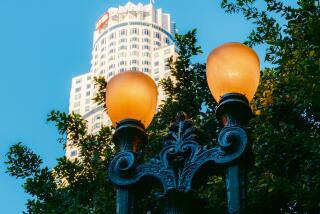LIGHTING : Proper Lamp Placement Stretches Room
- Share via
Lamps and lighting can be effective decorating tools. Adding one or two lamps and experimenting with their placement doesn’t take any special skills or experience, but it can do wonders for a room.
Even if you have an adequate amount of light from fixtures, you still want table lamps because of their decorative value, says designer Andrew Reczkowski. “Interesting old lamps have presence, form and style, and are an affordable accessory that adds character.”
Lamps can be from different periods when used in eclectically furnished rooms, Reczkowski says. But the impression will be less jarring if all the lamps and shades are about the same height.
The main problem with old lamps is that they are often missing their period shades. Having a correct-period shade made can cost far more than the lamp itself, so consider designing your own shade.
Reczkowski designed an inexpensive, but effective, lampshade to go with a bronze Art Deco lamp purchased in an antiques shop. He applied braid and tassels and had a friend paint a scene on the plain white shade.
Another idea: Glue old sepia photographs onto a translucent lampshade. “When you turn the light on, the photos are cast in amber glow,” he says.
A lamp casts a general light and creates a small vignette when used on a table with other accessories such as framed photographs. But don’t rely on just a single vignette, Reczkowski says. You should have three or four vignettes distributed throughout the room.
Although you can illuminate a room entirely with lamps, lighting fixtures extend what can be done with light.
For a dining room with a ceiling too low for a chandelier, designer Mary W. Delaney had an electrician recess a group of tiny lights into the center of the ceiling over the table. By drawing the eye upward, the light creates the illusion of a higher ceiling. However, Delaney cautions, precise placement of the lights is essential. If they are placed too close to the wall, the illusion will be lost.
Some other tips from Delaney:
* When a ceiling is a little too high for the proportions of the room, illuminate it around the edges, using strips of tiny halogen lights mounted behind or above the crown molding. The transformer that comes with the lights must be mounted and attached to an electrical source, so this is probably not a do-it-yourself installation.
* To make a long, narrow hall more attractive, hang pictures or apply pilasters (flat columns), then illuminate the wall decor with track-mounted spotlights.
* To lower the apparent height of a wall, light the middle section. Hang a picture that is wider than it is tall in the middle of the pool of light. The eye will be attracted to the picture, and the area above will be less noticeable.
Sconces, decorative lighting fixtures usually hung in pairs, are also an effective way to cast light in the middle of a wall. By experimenting with placement, it’s possible to create the effect of more or less height or length in a room. Delaney suggests placing sconces at either side of a sideboard, a mirror or a picture to draw attention to the feature.
“Sconces are available in virtually every style from American Colonial to Art Deco to formal 18th-Century French or English, so they can be decorating the room at the same time that they are lighting it,” Delaney says.

